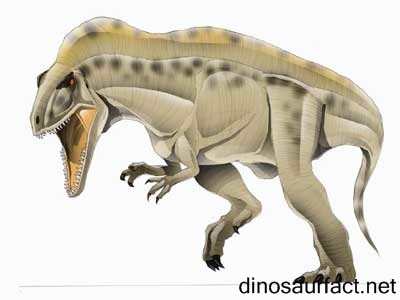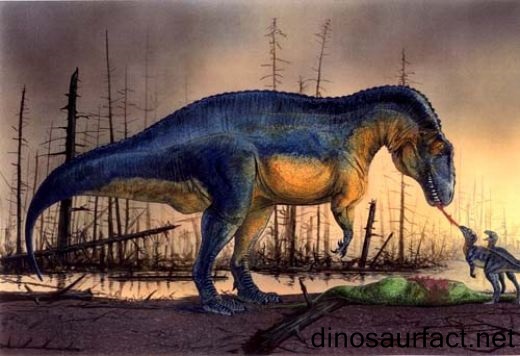 Click to visit the previous dinosaur bio
Click to visit the previous dinosaur bio
 |
|
 |
|
Kingdom: Animalia
Phylum: Chordata
Class: Sauropsida
SuperOrder: Dinosauria
Order: Theropoda
SubOrder: Carnosauria
Family: Carcharodontosauridae
Genus: Acrocanthosaurus
 |
|
 |
|
 |
|

The Acrocanthosaurus was a dinosaur that existed on the earth in the early Cretaceous period of the Mesozoic era. It is believed to have been present about 125 to 110 million years ago. Its fossils were discovered in the United States, predominantly in Texas and Oklahoma. But it likely inhabited the whole of the North American continent.
The Acrocanthosaurus was a large dinosaur. Its length was about 11 to 12 meters from head to tail. Its weight is approximated at 6000 to 6500 kilos. The neck and the fore legs of the Acrocanthosaurus were muscular and strong. Its hind legs were stout. They were not adapted for running, thus indicating that the Acrocanthosaurus had a slow gait.
Many comparisons are made between the Acrocanthosaurus and the Tyrannosaurus although the two are not related genera. This is because both of these dinosaurs were carnivorous and of comparable sizes.
The Tyrannosaurus had fore limbs which were shorter as compared to the Acrocanthosaurus. Its teeth were stronger than those of the Acrocanthosaurus and it also existed much later in history as well.
Etymology
The name of the Acrocanthosaurus is derived from its distinct thoracic, lumbar and sacral spinal processes. The word 'acrocantho' has Greek origins and translates to 'tall vertebral column'. The word 'sauros' means 'lizard' in Greek. Thus, the name 'Acrocanthosaurus' means 'the lizard with the tall vertebral column'.
The binomial name Acrocanthosaurus atokensis is derived from the location where the holotype of the species was found, Atoka County.
The naming of the dinosaur was done by J. Stovall and W. Langston, Jr.
Discovery of fossils
- The first fossils ascribed to the Acrocanthosaurus were discovered in the Antlers Formation in Oklahoma in 1942. These consisted of an intact skull along with other bones.
- Two more specimens were discovered in 1990 which had much better preserved bones. They were found in the Twin Mountains Formation in Texas and again in the Antlers Formation in Oklahoma.
- On the basis of these findings, almost all of the bones of the Acrocanthosaurus are available today. They provide plenty of information about the dinosaur.
- The Cloverly Formation of Wyoming has also yielded a few bones which are ascribed to the Acrocanthosaurus.
- A few fossils have also been discovered in the Arundel Formation (Maryland) which may belong to the Acrocanthosaurus.
- There are many footprints seen in the Glen Rose Formation which may have belonged to the Acrocanthosaurus.
Structure of skull
Structure of the forelimbs
The forelimbs of the Acrocanthosaurus were much more dexterous than those of the Tyrannosaurus. Although the movement of the shoulder and the humerus did have as much range of motion as a typical ball and socket joint, it had enough flexibility to allow the Acrocanthosaurus to hold its prey. It probably could rip its kill apart with its arms. Its teeth were not strong enough to break bones.
The spinous processes
The tall spinous processes provided insertions for strong chest and back muscles. Such structures are seen in modern day camels, horses, etc. Some scientists had postulated that the ‘hump’ was used it a fashion similar to camels, to store nutrition when food was scanty. But this theory is considered highly unlikely today.
Classification
The Acrocanthosaurus is classified under order Theropoda, clade Carnosauria and family Carcharodontosauridae.
In 1956, it was classified under the family Megalosauridae. But this family is disregarded today.
Due to its long spinous processes, in was considered a member of family Spinosauridae in the 1980s. But in depth research has shown otherwise.
It was thought in the late 1980s that the Altispinax was a sub species of the Acrocanthosaurus. But later it was classified under a new genus Becklespinax.
The Acrocanthosaurus is considered a primitive member of the clade Carnosauria.
Physical features
- The Acrocanthosaurus was an enormous dinosaur. Its adult size was about 39 to 41 feet. Its weight at full growth was about 6 to 6.4 tons. Some scientists had estimated it’s mass to be over 7.5 tons. But this figure is highly unlikely considering the nature of the bones of the Acrocanthosaurus.
- Its head was very large, about 4.5 to 5.5 feet in length.
- The teeth of the Acrocanthosaurus were relatively delicate and curved inwards. It is unlikely that it could break hard objects with its teeth.
- The tall spines formed a hump along its back.
- The arms of the Acrocanthosaurus were moderately long and muscular.
- The length of the femur of the Acrocanthosaurus was significantly longer than its tibia. This indicated that it could not run fast.
- The size of the feet of the Acrocanthosaurus was almost half the size of those of the Tyrannosaurus. This shows that walked on hard, unyielding surfaces.
- Its tail was long and used for maintaining its center of gravity near its pelvic region.
Habits and habitat
It walked on its hind legs, i.e. it was bipedal. Its forelegs were too short to touch the ground or offer support while walking.
It used its arms to restrain and overwhelm its prey. Its teeth were not strong enough to snap bones and hence using its forearms for attack was a necessity.
The habitat of the Acrocanthosaurus was dry. This is determined by the size of its feet. If it lived near marshes or wetlands, its legs would have sunk inside it ground while walking. The climate of the regions where the Acrocanthosaurus lived was hot and humid.
Related and coexisting species
The Acrocanthosaurus is believed to be related to the Allosaurus, the Giganotosaurus and the Carcharodontosaurus.
It is thought that the Deinonychus existed alongside the Acrocanthosaurus.
The Paluxysaurus and the Tentosaurus are also thought to have coexisted with the Acrocanthosaurus. They were most probably hunted by the Acrocanthosaurus.
Epilogue
The Acrocanthosaurus was right at the top of the food chain during its era. Its appearance heralded the reign of other dominant dinosaurs like the Tyrannosaurus. Although the Acrocanthosaurus is neither related to nor as popular as the T. rex, it was still an important theropod of the Aptian and Albian ages Cretaceous period.
Index
Extinct Profiles
 Triassic Dinosaurs
Triassic Dinosaurs Jurassic Dinosaurs
Jurassic Dinosaurs Cretaceous Dinosaurs
Cretaceous Dinosaurs Pterosaurs
Pterosaurs Marine Reptiles
Marine Reptiles Dinosaur Extinction
Dinosaur Extinction